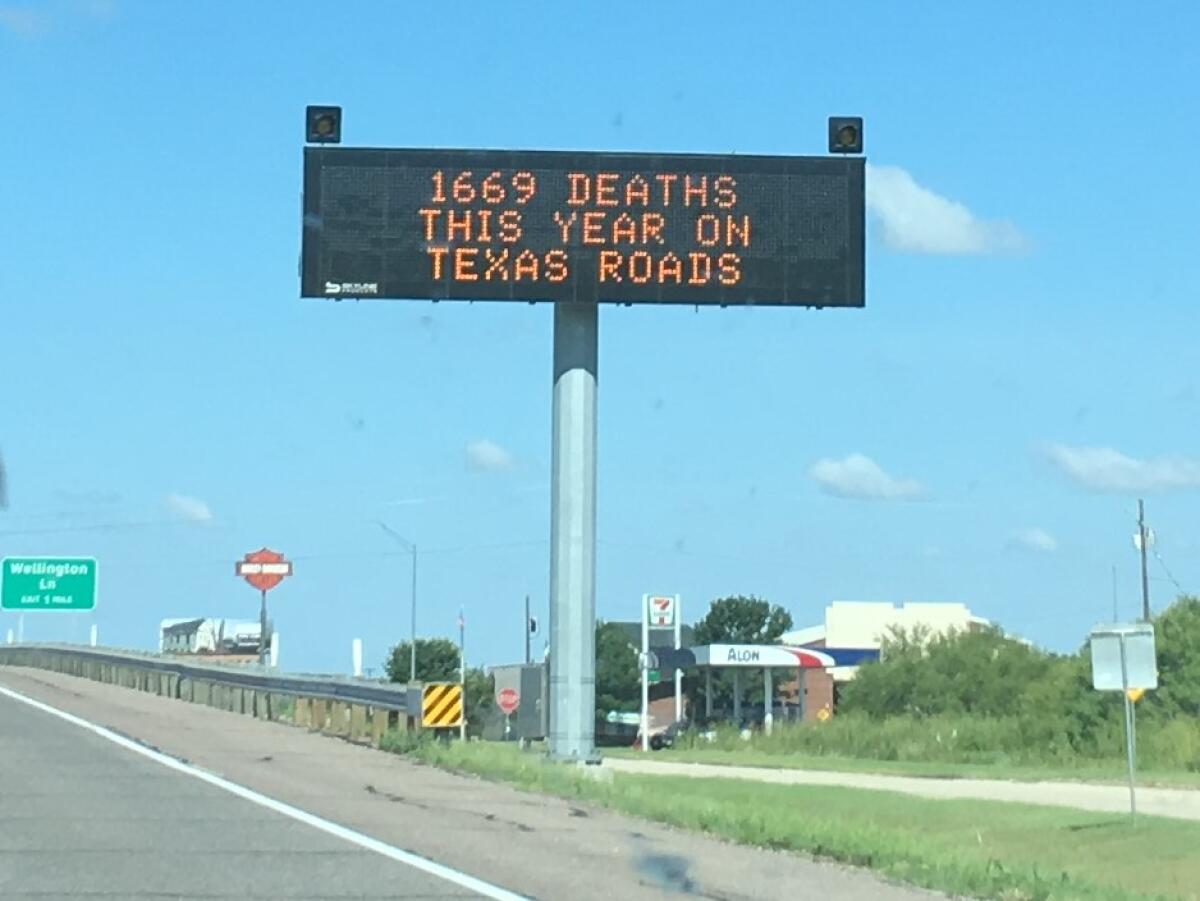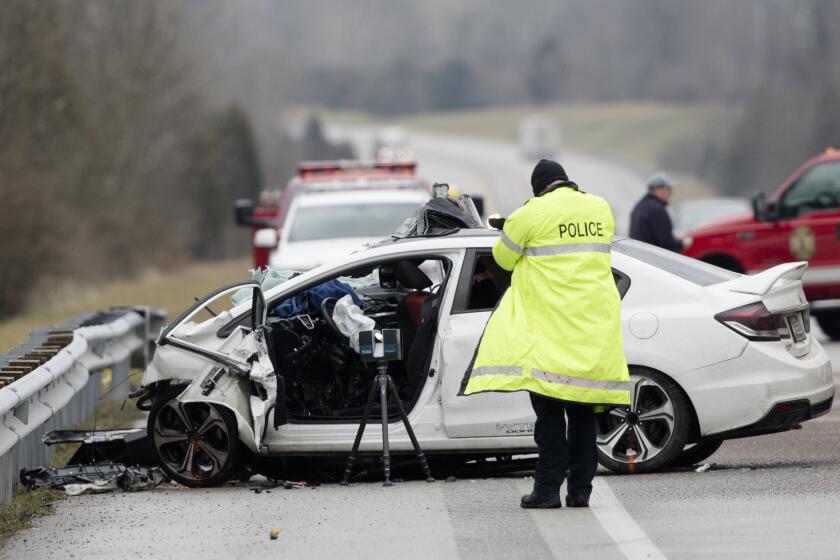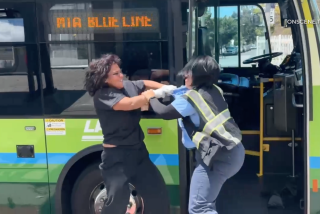Texas reminded motorists to drive safely. It didn’t work out as planned

- Share via
Car accidents are a leading cause of death in the U.S., and more than half of U.S. states have embraced a seemingly low-cost, high-impact strategy to drive home just how dangerous the roads can be: posting annual highway death tolls on digital roadside message boards.
New research suggests that these signs do, in fact, grab motorists’ attention — just not in the way policymakers had hoped.
Scientists studying highway collision data from Texas found that motorists who passed a message board announcing annual traffic fatalities were 4.5% more likely to get into an accident over the next 10 kilometers (6.2 miles) than drivers unburdened by the information.
What’s more, the likelihood of an accident increased along with the posted death toll. The most hazardous time of the year was January — the month when signs displayed the grand total of road deaths for the previous year.
In total, a project intended as a budget-friendly way to reduce highway accidents appears to have directly contributed to an additional 2,600 crashes, 16 deaths and $377 million in costs per year in Texas, according to the study published Thursday in the journal Science.
Evidence suggests the pandemic has made U.S. drivers more reckless — more likely to speed, drink or use drugs and to leave their seatbelts unbuckled.
Texas is one of at least 28 U.S. states that have advertised annual traffic deaths as part of their roadside safety messaging. But the state was unique in that its drivers saw the death counts exactly one week each month: the week before the Texas Transportation Commission’s monthly board meeting. The easily trackable schedule turned out to be a boon for the research team.
“God bless Texas,” said Joshua Madsen, an accounting professor at the University of Minnesota’s Carlson School of Management, who conducted the study with Jonathan Hall, a professor of economics at the University of Toronto.
The pair reviewed 2 ½ years of highway crash data from before the sign program started in August 2012, plus five years of data from 2012 to 2017. They found there were more collisions in weeks when death count messages ran, with the greatest concentration of accidents in the 10 kilometers immediately following the signs.
Most crashes were multi-vehicle incidents, and they tended to happen when there were lots of additional demands on drivers’ attention, such as heavy traffic, complicated interchanges and areas with multiple signs.
Ultimately, the safety messages had the same effect on collision rates that one would expect from signs raising the speed limit by 3 to 5 mph, the researchers concluded.
The fatality counts do appear to have captured drivers’ attention. The problem was that they hijacked that attention when it was most needed on the road.
The next time you’re tempted to make a phone call while you’re behind the wheel, remember this: Dialing while driving increases the risk of a crash or near-crash more than any other sort of distraction.
Safe driving demands continuous attention on the task at hand, or what’s known as goal-directed attention. It can be easily thwarted by stimulus-driven attention, or the notice a driver gives to a sudden distraction, said Dr. Donald Redelmeier, a University of Toronto professor and physician at Toronto’s Sunnybrook Hospital, home to Canada’s largest trauma center.
“We did not evolve to travel at 70 or 80 miles per hour. It’s not the way our brains are designed,” Redelmeier said. “One or two seconds of inattention can make all the difference in the world when you’re driving a motor vehicle.”
Case in point: Redelmeier co-authored a 2017 study that found fatal motorcycle accidents increased during full moons, and shot up further during supermoon events. Stimulus-driven attention is most drawn to things that are large, bright and unexpected — three qualities shared by full moons and large electronic signs blaring shocking death tolls.
Once Madsen and Hall had their data in hand, they contacted transportation officials in states where the message boards were used to share their findings. Few responded directly, and those who did seemed reluctant to accept that their well-intentioned intervention might not have the desired outcome, Madsen said.
“One of them — I won’t say which state it was — basically emailed back and said, ‘This is an interesting study, thank you for the feedback, [but] we think ours is going to help in the long term,’ ” he said.
The Texas Department of Transportation declined to discuss the study publicly, but officials issued a statement about the results.
“We appreciate any focus on safety and the critical need to inspire drivers to make the best decisions behind the wheel,” the statement said. “In relation to this particular study, there are too many unknowns to draw any firm conclusions,” including that the signs distracted motorists.
Traffic deaths climbed again in Los Angeles in 2021, raising doubts about Mayor Eric Garcetti’s program to end such fatalities by 2025.
Texas’ unfortunate signage is hardly the first public campaign to backfire. One memorable 1999 study found that injuries incurred during charity skydiving events designed to raise money for Britain’s National Health Service wound up costing the NHS nearly 14 times more than they raised.
But as behavioral interventions, or nudges, become a more common tool for policymakers eager to shape people’s behavior, the results in Texas demonstrate the necessity of following good ideas up with equally good testing.
“Well-intentioned behavioral interventions are always educated guesses, so whenever practical, these interventions should be carefully tested at a smaller scale before they are implemented at a larger scale,” said Craig Fox, a behavioral scientist at the UCLA Anderson School of Management who has written on nudges gone wrong. “Oftentimes our intuitions and predictions about what will work — even when informed by solid behavioral science — turn out to be wrong.”
Madsen said the Texas Department of Transportation cooperated with the researchers in sharing data. Once the results were in, however, “they basically went radio silent.”
To the best of his knowledge, Madsen added, Texas stopped using the signs last year. The state acknowledged in its statement that it no longer posts the fatality counts.










